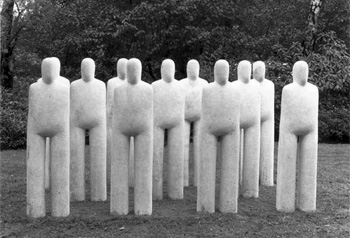| Machines, 1974 Concrete, white, group of 11 160 x 306 x 160 cm Created during the Symposium for Young Sculptors of the Town of Velbert |
||
| Our current way of life frequently threatens a loss of individuality. The robot, the man-machine, is effectively no longer fiction. Although this is nothing new, it forces me to explore, and to this end I make use of the artistic means of expression available to me.
I call my Velbert piece “Machines”. The individual figures are reduced to their essential form; they have no defined arms or facial features. But all that is there and could start moving at any moment, yet the figures no longer have any personality. Eleven of these figures, each the same as the next, are positioned in a group at specified distances from one another. People from the conveyor belt, on the conveyor belt, as a conveyor belt. The distances between the figures are small enough to restrict lively movement. Here observers can physically experience the power of the man-machine. The fact that most adults are taller than the figures is but a momentary illusion. The material’s lack of colour intensifies the threat of the petrification of the individual into a “non-person”. The man-machine is active as a single piece and aggressively multiplies to form a group. This is also how the figure is intended to appear to the observer. My work aims to get people thinking and provoke reflection: with the loss of their individuality, man becomes machine. Yet my works have no fixed content. The Velbert piece is also deliberately ambiguous. In my opinion an artist must not impose his own ideas on which the work is based on the observer; he has to express them and at the same time allow room for subjective interpretation. Life experiences are what shape a person, and that person will correspondingly respond to encounters, including artistic ones. It is this experience I likewise consciously seek with “Machines”. |
||

